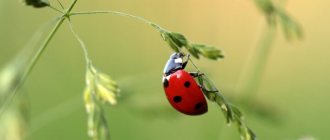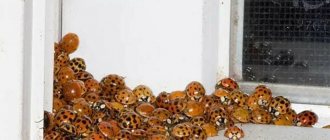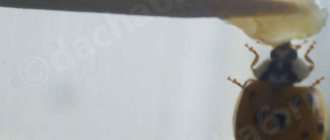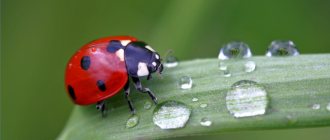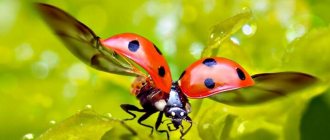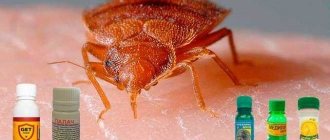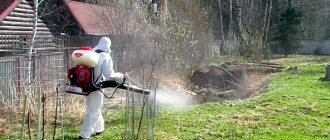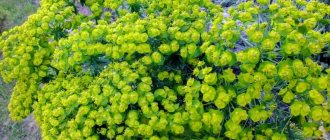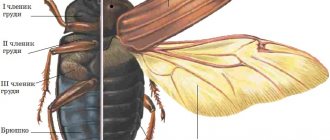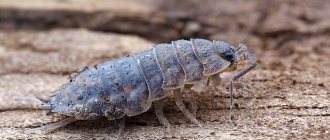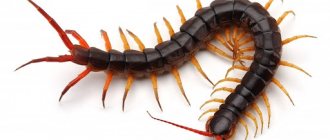Ladybugs, or scientifically Coccinellidae, are a family of beetles (there are more than 5,200 species worldwide) with bright warning colors: a combination of red, yellow, white and black. When disturbed, ladybugs secrete droplets of pungent orange hemolymph, making them inedible to most insectivores. For us, the main importance is the fact that ladybugs and their larvae are predators (not all, there are herbivorous species, but more about them below), feeding on aphids, scale insects and other small insects. Many species are “attached” to certain vegetation. Some of them live mainly on trees (Adalia bipunctata), others on herbaceous vegetation (Coccinula quatuordecimpustulata), and there are generalists.
Ladybugs live from several months to a year, rarely - up to two years. Juveniles are always brightly colored, which gradually fades with age.
Who is most useful to us? Who should you love especially?
The most useful are the seven-spotted ladybug (Coccinella septempunctata) and the two-spotted ladybug. The two-spotted ladybug (Adalia bipunctata) is a generalist and feeds on a wide variety of aphids.
Seven-spotted ladybug
And there are narrow professionals, such as the pine ladybug (Exochomus 4-pustulatus), which is limited to pine trees, where it looks for its food source, or the heather ladybug (Chilocorus 2-pustulatus).
Two-spot ladybug
How to lure the “sun” to the site
If you want to attract ladybugs to care for your garden and vegetable garden, making them personal orderlies for your dacha, you will have to make tangible sacrifices. Rule No. 1: no chemicals! It’s hard to imagine, because in modern realities, summer residents spray their garden crops several times a season. In particular, in order to protect plants from the negative effects of diseases and parasites. But a ladybug will never fly to a place that smells of pesticides. Which, in general, is quite logical: the beetle fears for its life and does not want to be killed.
Life cycle of ladybugs, coccinellids
The life cycle of a ladybug is similar in many species.
1. Adults spend the winter, often in large groups, in any dry and (if possible) place protected from the wind.
2. In spring, in May, reproduction begins.
3. Egg laying continues until July, and in some species each female lays up to 1000 eggs. Many carnivorous species of ladybirds lay their eggs near aphids , providing a food supply for their young. The eggs take about 4 days to hatch depending on the temperature.
4. Coccinellid larvae molt 3 times (that is, they have 4 instars) and after about 3 months, depending on the density of the aphids, pupate. Ladybug larvae, when small, are often smaller than the aphids they eat. The 7-spotted ladybug larva eats more than 300 aphids before pupating.
5. Then the pupal stage and the emergence of the adult. The pupa's skin splits along the back and the adult emerges. At this stage the elytra are pale yellow-orange, but soon lighten in color after a few hours or days.
Life cycle of a ladybug
6. Young adult coccinellids feed for several weeks before dispersing and finding a wintering site.
Most ladybugs produce one generation per year, but some, such as the two-spotted (2-) and fourteen-spotted (14-) ladybugs, produce two generations per year.
Natural attraction
In order for the “suns” to want to fly to your garden plot on their own, you will have to work a little. And eliminating the use of chemicals is just the beginning. Ideally, you should try to recreate the pristine natural environment on the site in miniature. For example, a small lawn on which wildflowers and herbs are planted. There is no need to mow the grass on such a lawn. It’s also not worth clearing it of leaves, which will begin to fall from garden trees in early autumn. This way you can create a favorable environment for attracting not only “suns”, but also other insects that can make an invaluable contribution to the protection of your plants.
According to legend, the ladybug is an integral part of the heavenly herd of the god Perun. In ancient times, as today, they tried not to offend these insects. People believe that because it belongs to celestial phenomena, the brightly colored insect can influence the weather.
HARMFUL ladybugs
There is also harm from ladybugs, not only benefits. At the very beginning, we said that there are species that are herbivorous. So, we present to you the enemies:
Potato ladybird, or 28-spot ladybird (Henosepilachna vigintioctopunctata) - the species feeds on the foliage of potatoes and other nightshade crops. Causes damage to agricultural crops, especially potatoes, as well as pumpkins, turnips, radishes, beans and spinach.
Potato ladybug, or 28-spot ladybird
The melon ladybird (Henosepilachna elaterii) is a phytophage, not a predator. Larvae and adults feed on the pulp on the underside of leaves. Melons, watermelons, pumpkins, cucumbers, zucchini, eggplants, spinach, and salads are damaged. Damages melon crops mainly in Central Asian countries.
melon cow
Harm and benefit
Harm:
- Asian coccinellids eat grapes and fruit trees. With their enzymes they worsen the taste of products.
- The Asian species of insect bites painfully. Skin irritation, swelling or swelling may occur at the bite site.
- Harlequins and Asian ladybugs are moving en masse to residential buildings for the winter. Their secretions leave traces and unpleasant odors on furniture, window sills, etc. They can cause allergic reactions.
- Destruction of crops by phytophagous beetles.
- Displacement of other insects by harlequins.
Lacewing
Another insect that gardeners often get is the lacewing. “A pest or a protector in front of me?” - the man thinks and, just in case, drives away, or even destroys the poor thing.
But an experienced gardener knows that this light green insect, similar to a dragonfly, is one of the most important enemies of aphids. But this beauty does not harm the garden, does not eat fruits, does not sharpen wood, and does not feed on “work colleagues.” Why is she offended? Most likely, this comes from simple ignorance. And the appearance of the larva has an effect - to those who are afraid of insects, they all seem the same. In fact, it is the larval form that eats most of the aphids. Adult insects often feed not on the pests themselves, but on the sweetish substance they secrete.
Who is this lacewing? Pest? Or is it still a defender? Rest assured, this insect will only benefit your garden by eliminating enemy aphid colonies.
A close relative is the spider
In fact, this creature is an arachnid, but many gardeners still perceive it as a beneficial insect. Spiders catch not only annoying flies in their webs, but also some garden pests.
Since we are talking about spiders, perhaps we can also pay attention to earthworms, which are also not insects, but are firmly associated with them. They loosen and saturate the soil with organic matter.
Always excellent menu
Bright and cute beetles are considered dangerous predators for many insects. They eat:
- aphids;
- ticks;
- small caterpillars;
- eggs of moths and Colorado potato beetles;
- furry dolls.
However, this is not all that the ladybug eats, living among lush greenery. Some species eat only plant foods. They love to eat mushrooms. They do not refuse pollen, bud petals, or leaf blades. The insects' diet even includes various soft-textured fruits.
Unfortunately, there are varieties of ladybugs that cause damage to valuable crops. For example, in the Far East, a beetle with a 28-point color causes damage to potatoes. In the southern regions there are ladybugs that feed on the greens of legumes, tops of sugar beets and alfalfa.
Artificial attraction
If all efforts to recreate the bosom of nature were in vain, and ladybugs, despite your work, still did not dare to move closer to your garden, do not despair. In the end, you can always buy “suns”. All you have to do is find an environmental company on the Internet that sells living goods and order the required number of bright bugs.
A storm of aphids should be released into the garden early in the morning. Preferably until the dew disappears from the grass. As an option, release in the evening, when twilight has already descended on the ground, and the grass is again covered with drops of dew, having forgotten about the summer heat and feeling cool. In the event that neither in the morning nor In the evening, dew is not observed; the lawn on which you will release insects should be irrigated abundantly by hand - using a spray bottle.
How to attract a beneficial bug to the garden
It is impossible to say exactly where the insect will want to settle. But in order for it to end up on your site and help you cope with parasites that harm vegetation, you need to try to make your garden attractive to this bug. And this means:
- limit chemical means of protection on the site or choose those whose use causes minimal harm to the insect;
- leave a small space on the site that does not need to be touched (mow and rake grass, leaves);
- in the city you can plant angelica and dill;
- leave dandelions and yarrows in some places on the site;
- Buckwheat, tansy and legumes are among those plants that may tempt a ladybug.
Osmia
The furry insects, similar to bees, are completely harmless. They bring great benefits to the garden. Osmia go to collect nectar even in weather conditions in which an ordinary domestic bee would not get to work. If you want these hard workers to live in your garden, get buildings with a thatched roof or simply place several pieces of wood with drilled holes in the area. They love osmium and elderberry branches without a core. This is just the perfect house for them.
This beneficial insect can settle in the most unexpected place: in the hole of an old nail or a door crack.
Insect nutrition
The main feature of the ladybug for every summer resident is her love for aphids. More precisely, eating this pest. Interestingly, in search of its favorite food, an insect can cover a considerable distance. Adults of these nimble bugs can eat up to 150 aphids per day.
Some species include the following types of insects in their diet:
- whiteflies;
- scale insects;
- spider mites;
- Mealybugs.
There are even several species that eat fungal spores. Insects also love plant pollen and flower nectar.
Description of the insect
Surprisingly, about 5 thousand species of these bugs live throughout the globe . True, in the European part there are only 100. Insects love warmth, so they are active only in warm weather, and when it is cold, they fly less and do it much more slowly.
There is an opinion that the number of black dots on the body of a ladybug indicates the age of the insect - this is not so. Rather, from these points you can understand what species the bug belongs to.
A ladybug can be more than just red or orange. The ten-spotted ladybug has a dark brown color, the fourteen-spotted ladybird is yellow, the dotted ladybird is completely black, and the streaked ladybird is black with a yellow speck. There are representatives of the species that are very easy to confuse with other beetles. Moreover, not all of them are smooth; there are even very furry species of insects, which is unusual for us.
If you touch a ladybug, it will secrete a yellow substance with an unpleasant odor - this is a defensive moment that allows you to scare away creatures that are dangerous to the insect.
Trichogramma
This microscopic parasitic insect brings enormous benefits precisely because of its lifestyle. Trichogramma larvae can live only at the expense of other organisms - eggs and larvae of other insects.
It is noteworthy that Trichogramma selects only clutches of pests for parasitism. This beneficial insect is dangerous to more than 90 species of harmful butterflies that feed on leaves and fruits.
Knowledge of the laws of nature helps to make life much easier and significantly reduce housekeeping costs. Try to make friends with little garden helpers, do not drive them away from the site or destroy them, and thanks to them you will be able to get an excellent harvest without using chemicals.
Constant assistants in pest control
The amazingly voracious insect with a bright color benefits gardens, vegetable gardens and agricultural crops. After all, it destroys a huge number of aphids. An adult eats about 100 pests per day, and a larva eats 50.
She does not hunt for her victims, but calmly searches for food, moving through the greenery. As a rule, colonies of aphids, spider mites, and clutches of moths are sure to be encountered along its path. Usually the beetle remains in one place until it completely destroys all pests. From this it is clearly seen how ladybugs benefit plants and people who engage in agriculture.
There are special enterprises where valuable beetles are grown and released onto agricultural land.
To attract insects to your garden or garden, you need to consider a number of factors. Typically, beetles stay away from areas where chemicals are frequently used on plants. If you limit the use of drugs, then after 6 weeks there will be much more insects.
As you know, ladybugs love to feast on the nectar and pollen of umbrella plants. They are especially attracted :
- dill;
- cilantro;
- wild carrots;
- yarrow;
- fennel;
- caraway.
You can also plant nasturtium, rose and calendula in the garden. Cabbage, radishes and tomatoes attract aphid colonies. Such crops will help attract ladybugs to the site. If desired, valuable beetles are purchased from special farms where they are bred. They are released early in the morning or late in the evening, when the plants are covered with dew. If for some reason it is absent, the crop is irrigated with water from a spray bottle. At first, the “pets” are closely monitored so that they do not fly away prematurely to another place.
As you can see, the biological importance of the ladybug for green spaces cannot be overestimated. Thanks to her unusually strong appetite, garden and vegetable crops develop successfully. The insect eats a huge number of pests, which contributes to abundant harvests. It has a nice appearance, so it evokes positive emotions in people. Let a caring ladybug always live in your summer cottages.
Additional measures
- To ensure that flowering plants attract the ladybug throughout the season, you need to start by planting those that bloom earlier. That is, you can plant buckwheat first, then dill, etc.
- It is believed that the goal of attracting a brightly colored beetle to your site is not to completely exterminate aphids, but to control the population of this pest.
- There is such a thing as artificial food - this is a dry powder that you can buy, spray it on an area, and feed the insects. If there is not enough natural food for ladybugs, they may leave the area, so sometimes you have to resort to such measures.
- And some gardeners actively use baits that are designed to attract bees.
